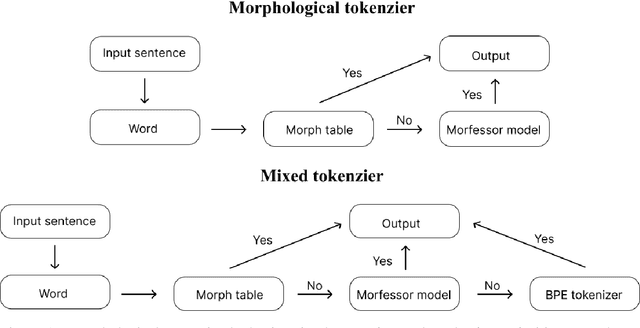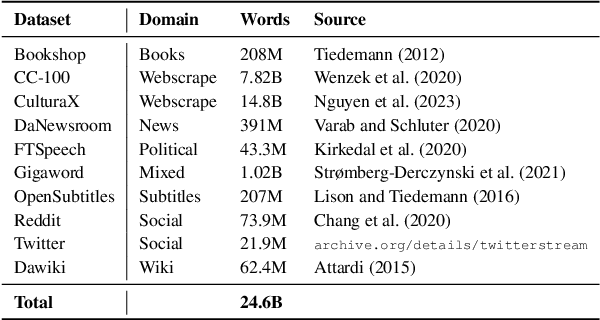Rob van der Goot
NLPnorth @ TalentCLEF 2025: Comparing Discriminative, Contrastive, and Prompt-Based Methods for Job Title and Skill Matching
Jun 23, 2025Abstract:Matching job titles is a highly relevant task in the computational job market domain, as it improves e.g., automatic candidate matching, career path prediction, and job market analysis. Furthermore, aligning job titles to job skills can be considered an extension to this task, with similar relevance for the same downstream tasks. In this report, we outline NLPnorth's submission to TalentCLEF 2025, which includes both of these tasks: Multilingual Job Title Matching, and Job Title-Based Skill Prediction. For both tasks we compare (fine-tuned) classification-based, (fine-tuned) contrastive-based, and prompting methods. We observe that for Task A, our prompting approach performs best with an average of 0.492 mean average precision (MAP) on test data, averaged over English, Spanish, and German. For Task B, we obtain an MAP of 0.290 on test data with our fine-tuned classification-based approach. Additionally, we made use of extra data by pulling all the language-specific titles and corresponding \emph{descriptions} from ESCO for each job and skill. Overall, we find that the largest multilingual language models perform best for both tasks. Per the provisional results and only counting the unique teams, the ranking on Task A is 5$^{\text{th}}$/20 and for Task B 3$^{\text{rd}}$/14.
DaKultur: Evaluating the Cultural Awareness of Language Models for Danish with Native Speakers
Apr 03, 2025Abstract:Large Language Models (LLMs) have seen widespread societal adoption. However, while they are able to interact with users in languages beyond English, they have been shown to lack cultural awareness, providing anglocentric or inappropriate responses for underrepresented language communities. To investigate this gap and disentangle linguistic versus cultural proficiency, we conduct the first cultural evaluation study for the mid-resource language of Danish, in which native speakers prompt different models to solve tasks requiring cultural awareness. Our analysis of the resulting 1,038 interactions from 63 demographically diverse participants highlights open challenges to cultural adaptation: Particularly, how currently employed automatically translated data are insufficient to train or measure cultural adaptation, and how training on native-speaker data can more than double response acceptance rates. We release our study data as DaKultur - the first native Danish cultural awareness dataset.
From Smør-re-brød to Subwords: Training LLMs on Danish, One Morpheme at a Time
Apr 02, 2025



Abstract:The best performing transformer-based language models use subword tokenization techniques, such as Byte-Pair-Encoding (BPE). However, these approaches often overlook linguistic principles, such as morphological segmentation, which we believe is fundamental for understanding language-specific word structure. In this study, we leverage an annotated Danish morphological dataset to train a semisupervised model for morphological segmentation, enabling the development of tokenizers optimized for Danish morphology. We evaluate four distinct tokenizers, including two custom morphological tokenizers, by analyzing their performance in morphologically segmenting Danish words. Additionally, we train two generative transformer models, \textit{CerebrasGPT-111M} and \textit{LLaMA-3.2 1B}, using these tokenizers and evaluate their downstream performance. Our findings reveal that our custom-developed tokenizers substantially enhance morphological segmentation, achieving an F1 score of 58.84, compared to 39.28 achieved by a Danish BPE tokenizer. In downstream tasks, models trained with our morphological tokenizers outperform those using BPE tokenizers across different evaluation metrics. These results highlight that incorporating Danish morphological segmentation strategies into tokenizers leads to improved performance in generative transformer models on Danish language
KARRIEREWEGE: A Large Scale Career Path Prediction Dataset
Dec 19, 2024Abstract:Accurate career path prediction can support many stakeholders, like job seekers, recruiters, HR, and project managers. However, publicly available data and tools for career path prediction are scarce. In this work, we introduce KARRIEREWEGE, a comprehensive, publicly available dataset containing over 500k career paths, significantly surpassing the size of previously available datasets. We link the dataset to the ESCO taxonomy to offer a valuable resource for predicting career trajectories. To tackle the problem of free-text inputs typically found in resumes, we enhance it by synthesizing job titles and descriptions resulting in KARRIEREWEGE+. This allows for accurate predictions from unstructured data, closely aligning with real-world application challenges. We benchmark existing state-of-the-art (SOTA) models on our dataset and a prior benchmark and observe improved performance and robustness, particularly for free-text use cases, due to the synthesized data.
SnakModel: Lessons Learned from Training an Open Danish Large Language Model
Dec 17, 2024



Abstract:We present SnakModel, a Danish large language model (LLM) based on Llama2-7B, which we continuously pre-train on 13.6B Danish words, and further tune on 3.7M Danish instructions. As best practices for creating LLMs for smaller language communities have yet to be established, we examine the effects of early modeling and training decisions on downstream performance throughout the entire training pipeline, including (1) the creation of a strictly curated corpus of Danish text from diverse sources; (2) the language modeling and instruction-tuning training process itself, including the analysis of intermediate training dynamics, and ablations across different hyperparameters; (3) an evaluation on eight language and culturally-specific tasks. Across these experiments SnakModel achieves the highest overall performance, outperforming multiple contemporary Llama2-7B-based models. By making SnakModel, the majority of our pre-training corpus, and the associated code available under open licenses, we hope to foster further research and development in Danish Natural Language Processing, and establish training guidelines for languages with similar resource constraints.
data2lang2vec: Data Driven Typological Features Completion
Sep 25, 2024Abstract:Language typology databases enhance multi-lingual Natural Language Processing (NLP) by improving model adaptability to diverse linguistic structures. The widely-used lang2vec toolkit integrates several such databases, but its coverage remains limited at 28.9\%. Previous work on automatically increasing coverage predicts missing values based on features from other languages or focuses on single features, we propose to use textual data for better-informed feature prediction. To this end, we introduce a multi-lingual Part-of-Speech (POS) tagger, achieving over 70\% accuracy across 1,749 languages, and experiment with external statistical features and a variety of machine learning algorithms. We also introduce a more realistic evaluation setup, focusing on likely to be missing typology features, and show that our approach outperforms previous work in both setups.
How to Encode Domain Information in Relation Classification
Apr 21, 2024



Abstract:Current language models require a lot of training data to obtain high performance. For Relation Classification (RC), many datasets are domain-specific, so combining datasets to obtain better performance is non-trivial. We explore a multi-domain training setup for RC, and attempt to improve performance by encoding domain information. Our proposed models improve > 2 Macro-F1 against the baseline setup, and our analysis reveals that not all the labels benefit the same: The classes which occupy a similar space across domains (i.e., their interpretation is close across them, for example "physical") benefit the least, while domain-dependent relations (e.g., "part-of'') improve the most when encoding domain information.
Can Humans Identify Domains?
Apr 02, 2024



Abstract:Textual domain is a crucial property within the Natural Language Processing (NLP) community due to its effects on downstream model performance. The concept itself is, however, loosely defined and, in practice, refers to any non-typological property, such as genre, topic, medium or style of a document. We investigate the core notion of domains via human proficiency in identifying related intrinsic textual properties, specifically the concepts of genre (communicative purpose) and topic (subject matter). We publish our annotations in *TGeGUM*: A collection of 9.1k sentences from the GUM dataset (Zeldes, 2017) with single sentence and larger context (i.e., prose) annotations for one of 11 genres (source type), and its topic/subtopic as per the Dewey Decimal library classification system (Dewey, 1979), consisting of 10/100 hierarchical topics of increased granularity. Each instance is annotated by three annotators, for a total of 32.7k annotations, allowing us to examine the level of human disagreement and the relative difficulty of each annotation task. With a Fleiss' kappa of at most 0.53 on the sentence level and 0.66 at the prose level, it is evident that despite the ubiquity of domains in NLP, there is little human consensus on how to define them. By training classifiers to perform the same task, we find that this uncertainty also extends to NLP models.
Big City Bias: Evaluating the Impact of Metropolitan Size on Computational Job Market Abilities of Language Models
Mar 12, 2024Abstract:Large language models (LLMs) have emerged as a useful technology for job matching, for both candidates and employers. Job matching is often based on a particular geographic location, such as a city or region. However, LLMs have known biases, commonly derived from their training data. In this work, we aim to quantify the metropolitan size bias encoded within large language models, evaluating zero-shot salary, employer presence, and commute duration predictions in 384 of the United States' metropolitan regions. Across all benchmarks, we observe negative correlations between the metropolitan size and the performance of the LLMS, indicating that smaller regions are indeed underrepresented. More concretely, the smallest 10 metropolitan regions show upwards of 300% worse benchmark performance than the largest 10.
Deep Learning-based Computational Job Market Analysis: A Survey on Skill Extraction and Classification from Job Postings
Feb 08, 2024Abstract:Recent years have brought significant advances to Natural Language Processing (NLP), which enabled fast progress in the field of computational job market analysis. Core tasks in this application domain are skill extraction and classification from job postings. Because of its quick growth and its interdisciplinary nature, there is no exhaustive assessment of this emerging field. This survey aims to fill this gap by providing a comprehensive overview of deep learning methodologies, datasets, and terminologies specific to NLP-driven skill extraction and classification. Our comprehensive cataloging of publicly available datasets addresses the lack of consolidated information on dataset creation and characteristics. Finally, the focus on terminology addresses the current lack of consistent definitions for important concepts, such as hard and soft skills, and terms relating to skill extraction and classification.
 Add to Chrome
Add to Chrome Add to Firefox
Add to Firefox Add to Edge
Add to Edge